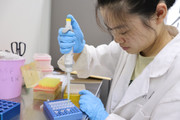Safety
Introduction
As we all know, iDEC attaches great importance to project safety. So our team put a high premium on the underlying risks to the health of experimental personnel, and the possibility of organism interaction during the experiment, which may cause unpredictable environmental problems.
Laboratory Safety
1. Safety assessment : For safer lab work, every one of our team has attended the laboratory safety lesson and took a biosafety examination. Only members who pass the lab safety test are allowed to conduct our experiments.

2. Wearing safety : Before entering the laboratory, operators must properly wear lab coats, masks, eye protection, and lab gloves to ensure their safety. Also, slippers and shorts are forbidden in the lab.

Fig.2 Standard dress code
3. Storage safety : The reagents used in the experiments should be stored at appropriate temperatures and in specific containers according to the corresponding storage standards. Flammable, explosive, and toxic reagents should be placed in specially customized safety cabinets under the supervision of specialized personnel.

Fig.3 Storage for some reagents
4. Hazard Precautions : Our labs are equipped with fire cabinets, shower heads, and other equipment to deal with emergencies such as fire.

Fig.4 Fire cabinets
5. Waste Disposal Safety : The waste generated from each experiment will be sorted and put into the appropriate bins for subsequent recycling and disposal.

Fig.5 Experimental waste bins
Project Design Safety
In the proof-of-concept experiment, we substituted safer amplified genes for dangerous human serum extraction. Also, based on the no-release principle, our final product is designed with a cell-free system, which provides a great extent of biosafety.
Although we performed the corresponding protein modifications, our protein mutants did not exhibit greater environmental adaptability. With the feature of room temperature inactivation and our standard sterile operation, we ultimately minimized the environmental contamination they caused.
At the same time, handling and disposing of our experimental waste under strict laboratory rules will not cause harm to the health of people or the environment.
Although we performed the corresponding protein modifications, our protein mutants did not exhibit greater environmental adaptability. With the feature of room temperature inactivation and our standard sterile operation, we ultimately minimized the environmental contamination they caused.
At the same time, handling and disposing of our experimental waste under strict laboratory rules will not cause harm to the health of people or the environment.


